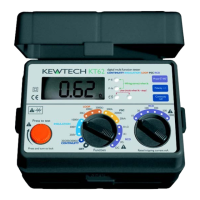Insulation tests
14
before the test include:-
▲ Electronic fluorescent starter switches
▲ Passive infra-red detectors (PIRs)
▲ Dimmer switches
▲ Touch switches
▲ Delay timers
▲ Power controllers
▲ Emergency lighting units
▲ Electronic RCDs
▲ Computers and printers
▲ Electronic point-of-sale terminals (cash registers)
▲ Any other device which includes electronic components.
5.3 Preparation for measurement
Before testing, always check the following:-
1 The ‘low battery’ Indication is not displayed
2 There is no visually obvious damage to the tester or to the test
leads
3 Test the continuity of the test leads by switching to continuity test
and shorting out the lead ends. A high reading will indicate that
there is a faulty lead or that the fuse is blown.
4 Make sure the circuit to be tested is not live. A warning
lamp is lit if the instrument is connected to a live circuit but test
the circuit as well!
5.4 Insulation resistance measurement
The KT62 has a selectable, triple test voltage of 250V, 500V and 1000V
DC.
1 Select the insulation resistance setting by rotating the function
dial to the required test voltage - 250V, 500V or 1000V as
indicated under the ‘insulation’ test section of the functional
switch, after making sure that the instrument is not connected to
a live circuit.
2 Attach the test leads to the instrument and to the circuit or the
appliance under test (see Figs 7 & 8)
+
_
LO

